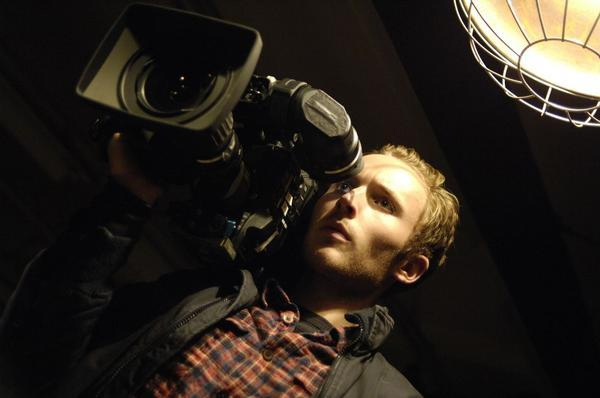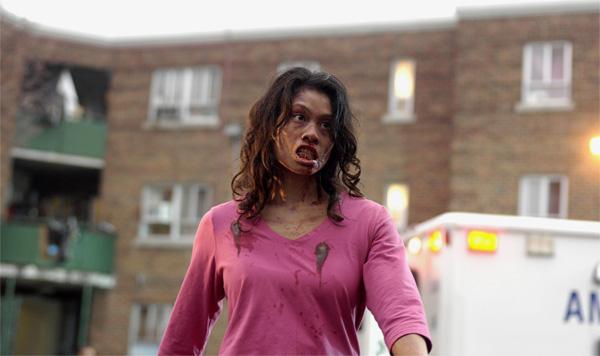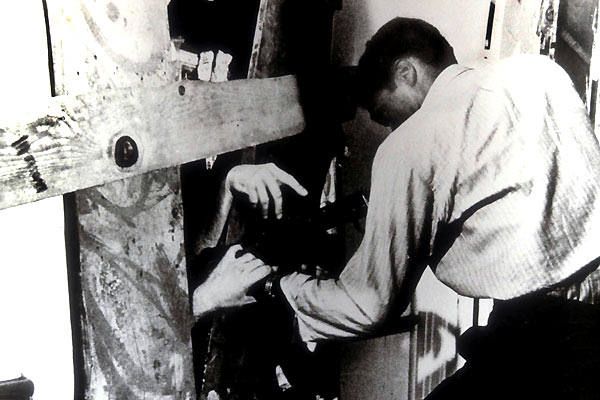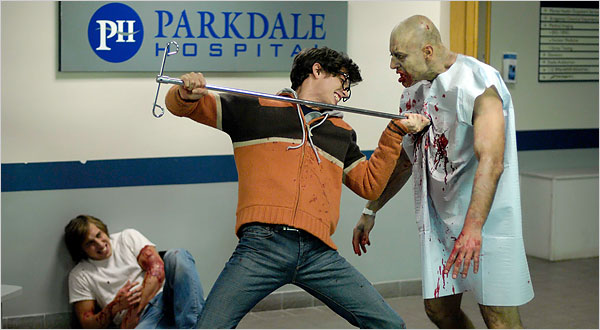 They’re coming for you…again!
They’re coming for you…again!
They may be all messed up, but George A. Romero’s flesh-eating ghouls seem to be gaining momentum, at least judging by the release date for DIARY OF THE DEAD – less than three years after 2005’s LAND OF THE DEAD. This is the shortest gap ever between two of Romero’s DEAD films, and it raises an interesting question. Since NIGHT OF THE LIVING DEAD redefined the zombie genre in 1968 with its documentary style and nihilism, the sequels have benefited from long gaps that allowed Romero not only to grow as a filmmaker but also to hurl Jackson Pollack-like gobs of grue against a changing cultural canvas; each film became a portrait of the apocalypse as seen from its particular time. Whereas the grim ending of NIGHT echoed with the horrors of search-and-destroy missions in Vietnam, DAWN OF THE DEAD (1979) cast a satirical eye on consumer culture, hinting that the walking dead were not much more soulless than the average customer in a shopping mall. During the “Me Decade,” DAY OF THE DEAD (1985) stated more clearly that the line between the living and the dead was a thin one and depicted remnants of a society whose collapse was brought about as much by self-destruction as by the undead. In the middle of the Iraq War, LAND OF THE DEAD (2005) presented a world in which society seems to have rebounded within a microcosmic “Green Zone,” where the affluent can lead happy lives, their beautiful minds untroubled by the ugly horrors screened off outside the perimeter of their high-rise luxury living space. Now, in 2008, instead of a sequel Romero offers us a reboot of the zombie phenomenon in DIARY OF THE DEAD, a film that explores the implications of the growth of new media, like the Internet, which allows everyone with a camera to become a reporter with an opinion on world events.
With the relatively brief time between films, the question becomes: Has the world has changed enough for Romero to find something new to say with the latest entry of his long-running magnum opus? Romero insists that concocting a new tale on short notice was not difficult.
“It wasn’t, because the idea was there,” he explains. “When we were shooting LAND OF THE DEAD, I already had a rough draft of the script [for DIARY]. I wanted to do something about this emerging media, this octopus that has us all captive, but then the deal for LAND OF THE DEAD happened and I put it in the drawer. I have to say Universal really let me make that movie; they were not all over my ass and really let me make the movie I wanted to make, but it was grueling, man. Also, I suddenly looked at it and it seemed too big, too THUNDERDOME. Where do we go from here? What do you do next – BEYOND PLANET OF THE APES?”
Romero’s answer to the question was to avoid making another sequel that advance the evolution of the zombies – a recurring motif since DAWN. For DIARY to work, he had to tell a new story that would begin at beginning. A group of film students are working on a mummy movie (titled “The Death of Death”) when the news hits that the dead are coming back to life. Abandoning their school project, they jump in a van and head for home, but it soon becomes apparent that the mainstream media are lying about the phenomenon, and within thirty-six hours, the major television and radio networks are out of commission. All that is left is the Internet, and student director Jason Creed decides to document the events and upload them to the world-wide web, in the belief that getting the truth out there will save lives.
Curiously, Romero does not fully endorse Creed’s quest, nor does he celebrate the Internet as a popular alternative to a mainstream media dominated by corporate interests. Instead, Romero depicts Creed as something of a self-deluded voyeur, who is disengaged from the events around him, refusing to leave his camera behind when it is plugged in to recharge (a subject never broached in CLOVERFIELD). Creed seems drunk on his fifteen minutes of fame, enthusing about the tens of thousands of hits his uploaded video is getting, while his friends, particularly his girlfriend Debra, are fighting for survival.
Why is Romero so dubious about a reaching millions of people through the Internet? He wants a balance between the old days of media conglomeration and today’s free-wheeling environment of uncontrolled information, which he calls “scary.”
“It strikes me as a bit dangerous,” he says. “People are captivated. Everybody has a camera. Right in the middle of Super Tuesday, it’s ‘There’s a tornado in Arkansas – if anybody can get me a shot, I’ll put it on the air and send you a CNN mug!’ So everyone’s a reporter.”
Coming from a filmmaker who cut his teeth in the ‘60s with a radical point of view, this nostalgia for the good old days when there were only three major television network “and Walter Cronkite was the most trusted man in America,” sounds almost reactionary. Iin recent years, the Blogosphere has emerged as progressive force, a useful corrective to the mainstream media monopoly that not only disseminated information but also interpreted. Except for MSNBC’s Keith Olberman, how much criticism is there of the Bush administration on any television network? Practically none. If you’re looking for someone willing to dissect topics like illegal wire-tapping and torture of prisoners, the Internet is the place to go.
“Yeah, but it might be the same guy who says, ‘Let’s get some guns and go kill all the bastards.’ It’s great that there’s all this freedom; I’m all for it. But it’s not just Arianna Huffington out there. It’s the would-be Jim Joneses. The Internet’s great for information, but take Iraq for an example. The basic information is that we’re at war, and then the casualties. After that, everything is opinion, and there’s no filter. It leads to tribalism. People who listen to Rush Limbaugh already know what he’s going to say and already agree with what he’s gonna say. Someone like Jim Jones could start a blog and reach millions of people.”
To be fair, Jason Creed is an ambiguous figure in DIARY OF THE DEAD, who passionately makes his case for what he is doing and eventually convinces his skeptical comrades, even Debra, to join in. Seldom stepping out from behind the camera lens, he reveals himself only in shadows and half-light that paint him as a sinister figure, and yet he stays true to his vision, unto the bitter end.
By presenting DIARY OF THE DEAD as if it were Creed’s film, Romero captures a documentary feel, sort of a digital updating of the hand-held black-and-white camerawork in NIGHT. Unfortunately, the technique may seem a bit overly familiar thanks to other recent releases.
“When I thought of this, it seemed completely new,” Romero laments. “I didn’t know there was gonna be REDACTED and CLOVERFIELD, where they were shooting with hand-held cameras.”
Despite the superficial resemblance to CLOVERFIELD, DIARY is ultimately a different sort of horror show. For one thing, Romero avoids the shaky-cam stylings of the J.J. Abrams-produced monster flick, which were prone to elicit reactions of sea-sickness in some viewers. In fact, Romero’s DIARY is closer to Brian DePalma’s REDACTED, which also combines hand-held images with footage supposedly culled from security cameras and weblogs. DIARY is not supposed to be a raw piece of “found” footage; it is presented as a finished film, which has been edited and even scored.
Achieving the student-made look of the movie might have seemed easy; in truth it was anything but. Romero’s established style in the previous DEAD movies was to keep camera movement to a minimum and shoot extensive coverage from multiple angles; he has said he would rather have “100 bad shots than ten good shots,” because with that many angles he believes there must be some way to cut the scene together.
“I still believe that, and if I had the money and the time, I would still do the 100 shots and be able to put it together any way I wanted to,” says Romero. “This, perforce, had to be much more disciplined. I’ve had people say to me, ‘It must be great to just turn the camera on and shoot!’ It required more discipline than anything we’ve ever done, because we were doing eight pages a shot; the camera was seeing all the way around, 360 degrees; the stunt guy had to duck under the lens; the guy with the stun gun had to duck under the lens. You had to not only choreograph the action but also choreograph the crew! Where do you put the lights? Here comes the lens…duck under. So it was choreographed down to the shoe-laces, which is the complete opposite of my old style, which used to be just run-and-gun: shoot a lot of coverage, shoot a lot of footage, and you could basically make it be whatever you want. It’s really the last three films – BRUISER, LAND OF THE DEAD, and this film – where the time-money equation just swallowed me up, and I had to plan everything down to the teeth. I actually liked it. I mean, I think that it probably forced me to think and pre-plan how I wanted to shoot it and how did I want to move the eye and what did I want to cut to from this and from that. Otherwise, I probably just would have kept going on the way I was going on, flying on instruments, shooting a lot of shots, and cutting it together later.”
Romero is particularly proud of the extended take the follows the characters into the house of Debra’s family, through the living room, into the dining room, into the garage, and back out of the garage before an attack takes place.
“The shot was twenty minutes,” says Romero, offering praise to his actors for pulling it off. “The cast was great. They had a lot of theatre experience. I think they could have gone from scene one all the way to the end of the movie, all in a single shot. The actors never blew it; if we blew it, it was always ‘Saw that light’ or ‘Saw that microphone.’”
Romero had originally intended DIARY OF THE DEAD as a “direct-to-video that would fly under the radar,” using real film students as crew (a la DePalm’s HOME MOVIES in 1980). However, when Romero’s producing partner Peter Grunwald showed the script to Artfire productions, he secured a budget this is “officially under” $4-million. Romero stretched his finances by shooting on high-definition video (which is more cost effective than film) and in Canada (where production is less expensive).
“It was going back to the roots and doing it really guerilla,” says Romero. The low budget prevented hiring any big name stars, but some familiar names do appear in the credits, having provided voice-overs for the various radio broadcasts heard in the film. “We did all the voices at first – my producer, my editor, my girlfriend – we tried ‘em on for size,” says Romero, who eventually enlisted friends and colleagues such as Wes Craven, Stephen King, Guillermo Del Toro, and Quentin Tarantino.
DIARY had a twenty-day schedule, with a few extra days for pick-up shooting. The fast pace of production necessitated the use of computer-generated imagery to augment of the on-set splatter.
“The whole idea is to get off the set, so it’s a lot easier to have somebody hold up a gun and a zombie falls. Then you paint in the flash and paint in the splatter,” Romero explains. “Some of these effects are fantastic. Actors don’t let you melt their heads, so some of those things were predictably CG.”
The use CGI may offend purists weened on Tom Savini’s outrageous prosethetic work in DAWN OF THE DEAD and DAY OF THE DEAD, but it works well in DIARY. Romero admits that the gore shots are his “ticket to ride…so that shit has to be there,” but he was willing to pull back on this film, and Greg Nicotero does a fine job with the zombie make-up, even if the hand-held camera style prevents the sort of lingering close-ups that showed off his work in LAND OF THE DEAD.
Romero talks about the obstructions of time and budget as perhaps not a necessary evil, but a manageable one, forcing him to plan ahead and think on his feet.
“That is what happens every day! You’re constantly faced with having to make compromises. I speak to the young aspiring filmmakers, and I say, ‘The most important thing is to know exactly what you want – and to prioritize what you want – because you’re going to have to cut something. You need to go in knowing what the least important thing is, and the next thing, and the next thing. And what the most important thing is – that’s what you have to preserve.’ People don’t get that. I’ve seen so many young filmmakers – even professional filmmakers who get a Hollywood deal – they don’t quite know where to begin, where to end, and they’ll waste a lot of time making this perfect shot, an establishing shot, and then there’s no time left to shoot the dialogue.”
This lack of discipline may be even worse in the DVD age, when deleted scenes can be added as bonus features on discs to turn them into “Special Editions.” That will not be happening with DIARY OF THE DEAD.
“No, man, on this film, there were no extras for the DVD,” says Romero. “All the extras on the DVD for DIARY are just going to be us talking about how we made the movie, because we didn’t have a minute to shoot something extra, so everything we shot is in the movie.”
Romero considers the result his “darkest” film since NIGHT OF THE LIVING DEAD, the big-bang that launched his career as a feature filmmaker. What is interesting in retrospect is that Romero, although a fan of classic horror, opted not to create a pastiche of the movies he loved while growing up; originally, he did not regard NIGHT as a zombie movie at all.
“For me, zombies were the slave workers in WHITE ZOMBIE [1932] with Bela Lugosi,” he explains. “I took the idea from Richard Matheson’s novel I Am Legend – which is now back with us [thanks to the film starring Will Smith] – I ripped off the siege and the central idea, which I thought was so powerful—that this particular plague involved the entire planet. I also felt that, rather than opening with a fait accompli, as in the book, it might be more interesting to observe the world during its collapse, to watch the disintegration of the old guard as its downfall is brought about. But I didn’t want to do vampires because he had already done vampires. So what could I do to make it my own? I made them flesh-eaters instead of blood-drinkers. But I never thought of them as zombies; I never called them zombies in NIGHT. They were ‘ghouls’ or ‘those things.’ But it was never really about them. They were just the problem driving the characters – it could have been anything, like a Hitchcock MacGuffin.”
In the original black-and-white masterpiece, the Living Dead represented a revolutionary threat to the status quo “but only in the broadest sense: a new society replacing the old and devouring it—literally.” Romero and his collaborators used NIGHT to take “swipes at the media, religion, at the misuse of family as an institution, and principally at tribalism – man’s inability to consider perspectives other than his own.
“We weren’t actually trying to use NIGHT OF THE LIVING DEAD as a forum for our socio-political leanings,” Romero continues. “They crept in through the back door. There was no racial statement when I wrote the script. It only came about because we cast Duane Jones. I didn’t realize it, but he did. This wasn’t a politically motivated choice; Duane Jones was simply the best actor among our friends and acquaintances. When I wrote that Ben gets shot at the end, he was a white guy.”
The scene, with a white posse mistaking the black hero for a zombie, was ripe for analysis, suggesting a lynch mob, killing an innocent man. Some critics were outraged (notably Roger Ebert, in his infamous review, reprinted in Reader’s Digest), but over the years the film has earned its share of critical respect.
One of Romero’s most vocal supporters has been Robin Wood, who views horror in general – and Romero’s zombie films in particular – as reactions to an oppressive patriarchal culture. Ironically, this radical critic has aged over the years until he has begun to sound little different from a typical oldster complaining “they don’t make ‘em like they used to,” remarking a few years ago that he had not seen a good horror film since DAY OF THE DEAD in 1985. Fortunately, with the release of LAND and now DIARY, Wood has plenty to keep him happy, and Romero, whose radical outlook has also been a bit mellowed by the passage of time, remarks, “Robin gets my movies, but he always finds a gay subtext in them that isn’t there, except in NIGHT RIDERS.”
In the forty years since NIGHT OF THE LIVING DEAD, Romero has made approximately a dozen films (depending on whether you count those he wrote but did not direct, such as the 1990 remake of NIGHT). Although he has tried his hand at in non-genre films (the aforementioned NIGHTRIDERS, the little-seen romantic comedy THERE’S ALWAYS VANILLA), Hollywood wants to keep him pegged not only as a horror filmmaker but more specifically as a zombie filmmaker. Does he consider himself typecast?
“Yes and no,” he laughs. “The answer is basically yes. I wish I would just get the phone call: ‘Hey, we got this project,’ but I don’t. But the flip side of that coin is I don’t know many other genre directors who have been able to express themselves or talk about society or do films that are socio-political satires and just use the genre as metaphor. So it’s pretty satisfying for me. I have this conceit that if you look at these five zombie films I’ve made, you get a glimpse that’s almost like looking through a kalaidascope of what was happening then. I guess that’s what I’m most proud of. I’ve never sort of just taken a job; I’ve never done a zombie movie just to do a zombie movie. The idea has to come and be first.”
Romero has been developing his ideas about the walking dead since 1968. During that time, many others have raised the cinematic dead, tilling the cemetery soil that Romero planted. Lucio Fulci directed ZOMBIE 2 in 1980, a film that, much to Romero’s chagrin, posed as a sequel to DAWN OF THE DEAD (which was re-titled ZOMBIE in Italy). Dan O’Bannon crafted the ersatz sequel RETURN OF THE LIVING DEAD in 1985. More recently, the videogame RESIDENT EVIL has spawned a trilogy of films. Romero was supposed to write and direct the first one; the American producers liked the script he delivered, but the German production company wanted to move away from video game, and the job ended up going to Paul W. S. Anderson. The RESIDENT EVIL films led to similar successes such as 28 DAYS LATER and the 2004 remake of DAWN OF THE DEAD.
Although Romero has enjoyed some of these films, he doesn’t care for zombies for zombie’s sake, and he thinks that the fast-moving variety make no sense (a point he makes, hilariously, in DIARY OF THE DEAD: Jason Creed directs the mummy in his movie to “shamble” because dead things have to move slow; otherwise, their ankles would break). Rather than follow this trend, he has stayed true to his original vision, even while adjusting it for each new film, and he has done it without losing the creative inspiration that distinguishes his work from a run-of-the-mill genre exercise – which is all too frequently what Hollywood churns out these days. Romero laments the lack of creativity evidenced by constantly remaking old films, including his own, and he has little good to say about the recent Torture Porn films.
“I’ve seen enough not to see any more,” he says. “Recent horror movies lack soul – and it’s not just horror. Take ATONEMENT: I brought some tissues with me expecting to shed a tear, and I didn’t. Later, I watched an old Bette Davis movie – the kind of thing you smile at because it’s so old-fashioned, but when it’s over, you do shed a tear.”
As for the future, LAND OF THE DEAD (which came closer than ever to presenting the zombies as a literal guerilla army revolting against human society) ended with the door wide open for a sequel that would develop the concept even further – but that will probably never materialize, since Romero has reconsidered his approach to the subject with DIARY OF THE DEAD:
“I would like to do something that picks up from where DIARY off, which I’ve never done before – same characters, same situation,” he says. “Not necessarily re-using the hand-held camera thing but a more traditional style. Maybe even go back and see some events from a different point of view since we’re not constrained by that anymore.”
Tracing the evolution of zombies was interesting for awhile, but the writer-director always considered the phenomenon of the walking dead as secondary to his thematic goals, which would be better served by this revised franchise. Calling himself the “Michael Moore” of horror masters, Romero says, “Maybe I am keeping the radical fires burning, but I can’t believe all these years later we elected Bush twice, and people are still sitting in front of the television, giving their last dime to some evangelist.”
A shorter version of this article posted on February 17 at 7:16pm. This is the complete, revised version.
[serialposts]




4 Replies to “Interview: George Romero documents the Dead”